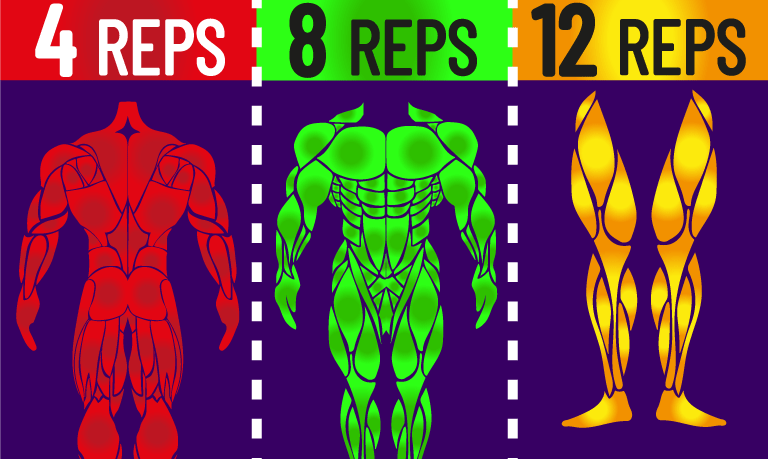
4 reps vs 8 reps vs 12 reps for strength and hypertrophy
We’re going to examine a recent study from Japan exploring this.
We’ll then detail how this study relates to the rest of the scientific research, from which we’ll derive highly useful rep range conclusions for those after strength, hypertrophy, or a combination of the two.
Let’s dive in.
Table of Contents
Part I: 4 vs 8 vs 12 reps for strength and muscle
The researchers recruited 42 physically active, but not resistance-trained men. Later we’ll discuss whether the untrained status changes our interpretations.
Subjects were assigned to one of four groups:
A 4, 8, 12, or control group.
We won’t mention the control group any further, they did not train and expectedly made no gains whatsoever.
The three groups all trained the bench press twice per week for 10 weeks.
In the first 2 weeks, all groups trained the same and pretty easy. The first week involved 3 sets of 10 reps with a 60% one-rep max load per session, while the second week involved 3 sets of 8 reps with a 70% one-rep max load per session.
I actually think this was a great thing to do, it likely helped accustomed the untrained subjects to bench press form.
In the third week, the three groups diverged in their training, and this week prepared the respective groups for their actual regimen that started from the fourth week onwards.
Specifically, the third week involved the 4 group training with 5 sets of 3 repetitions with a 90% one-rep max per session, the 8 group with 3 sets of 6 reps with an 80% one-rep max load per session, and the 12 group with 2 sets of 10 reps with a 70% one-rep max load per session.
From the fourth week until the end of the study, the 4 group trained with 7 sets of 4 reps with a 90% one-rep max load per session, the 8 group with 4 sets of 8 repetitions with an 80% one-rep max load per session, and the 12 group with 3 sets of 12 reps with a 70% one-rep max load per session.
All subjects rested 3 minutes between sets, which is a good strength of the study. Most studies tend to use short rests (1 minute or shorter) between sets, but we know with compound exercises, resting longer between sets tends to be advantageous for hypertrophy and strength.
Although 3 minutes of rest between sets were used, subjects weren’t always able to sustain their target rep numbers across sets due to the relative load used.
For example, someone in the 12 group may have hit 12 reps on the first set, but only 10 or 9 in the second and third sets.
Nevertheless, as subjects improved and managed to sustain their rep numbers across sets (so someone in the 12 group managed to perform 12 reps in all three sets), loads were increased by 2.5kg for the next session.
This ensured subjects kept training with the relative loads they were supposed to.
Now, the reason the sets numbers differed between the groups is as the researchers wanted to equate volume load (the product of sets x reps x load) between all three groups.
Before and after the 12 weeks of training, strength was assessed via bench press one-rep max, whereas hypertrophy was evaluated by pectoralis major volume
This is another strength of the study, volume is a 3D measure and takes into consideration the whole of a muscle. Many studies tend to only look at the cross-sectional area or thickness of a muscle, and this is typically done in only a single muscle region.
It was found pectoralis major volume increased similarly in all three training groups, while bench press strength was similar between the 4 and 8 group and both greater than the 12 group.
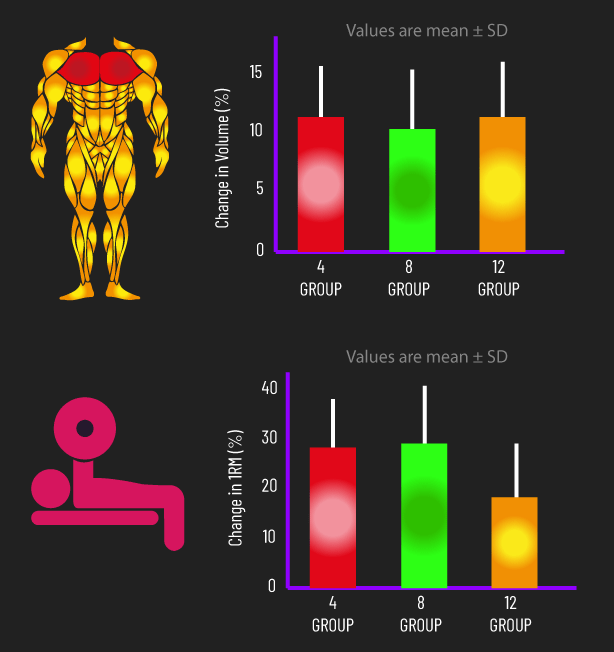
So this study suggests 4, 8, and 12 reps are comparable for hypertrophy, while 12 reps are notably less effective for strength than 4 and 8 reps.
Part II: A Deeper Exploration of Hypertrophy Rep Ranges
This study adds to the literature indicating a wide range of rep ranges are similarly effective for building muscle. The literature indicates this applies to both trained and untrained individuals.
Rep ranges simply aren’t overly important for hypertrophy, the key is for you to get to or close to failure with your repetitions (which was done in the study just overviewed). You probably want to get 3 or fewer reps from failure.
This runs counter to the popular “traditional rep range continuum” which states 6-12 reps are superior for building muscle, and is commonly seen in classic personal training textbooks and social media posts.
Now, we know set numbers were not the same between the three groups, as the researchers wanted to equate volume load between them.
Some may be thinking this proves volume load specifically is crucial and correlated with muscle hypertrophy.
Yet, I’m very skeptical of this, simply because as we explored in another article, numerous lines of evidence suggest volume load precisely is not related to gains.
Instead, a more accurate interpretation may be that lower reps (5 or fewer) are less efficient for stimulating growth per set , so require more sets to compensate for this and ultimately achieve similar growth to more reps with fewer sets.
I say this for 2 reasons:
Firstly, the literature tends to suggest when rep ranges are kept constant, more sets produce more hypertrophy (up to a point) – so with a rep range less effective per set, it’s logical performing additional sets can be effective compensation.
Secondly, other research supports this. A 2016 study from New York had trained men perform 3 sets per exercise a session, and found muscle growth outcomes were largely better when performing 8-12 reps to failure per set as opposed to 2-4 reps to failure per set.

Another 2014 study from New York found performing 7 sets of 3 reps to failure was similarly effective for hypertrophy outcomes versus 3 sets of 10 reps failure.
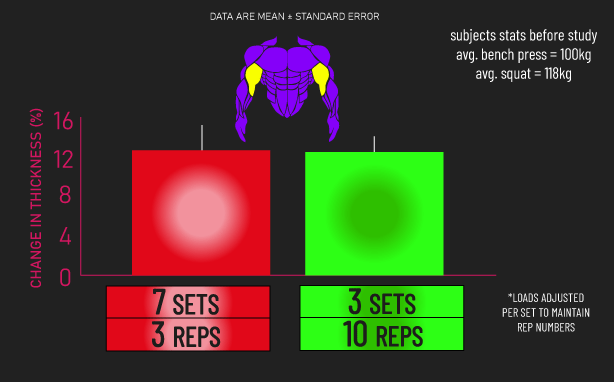
Stated another way, 5 or fewer reps are likely less effective per set for hypertrophy, but performing extra sets can adequately compensate for this.
I should also note that one or two reps per set might not be effective for hypertrophy at all, we’ve examined this evidence in another article.
Overall, reps between 6 and 35 are likely similarly effective for hypertrophy per set. For example, yet another 2015 study from New York found in trained men performing 3 sets per exercise a session, hypertrophy outcomes were similar between training with 8-12 repetitions to failure and 25-35 repetitions to failure.
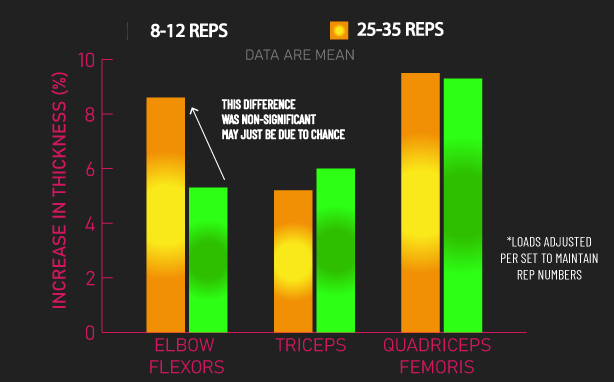
Some may be thinking hang on a minute, in the initial study we looked at, didn’t 8 groups perform more sets than 12 rep max group, so if per set 6-35 reps are similar, and more sets tend to be better, why didn’t 8 group see more gains.
My speculation is the set number differences were not big enough, remember the 8 group just performed 1 more set per session than the 12 group.
Summarizing this section, a wide range of rep ranges are similarly effective for hypertrophy in untrained and trained folks. Per set, reps between 6 and 35 are likely similarly effective.
3-5 reps may be less efficient for hypertrophy as it may require you to perform extra sets.
For those who care about time efficiency, this can be notable.
Here are the session durations from the initial Japanese study we assessed:
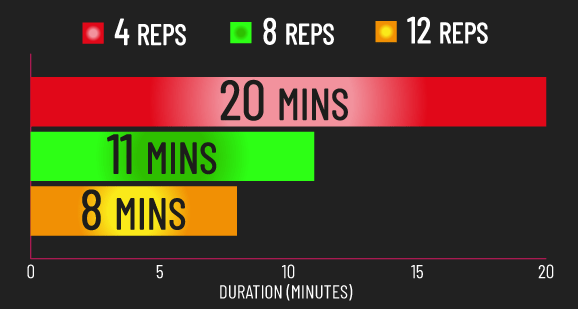
The 4 group spent nearly double the time training the bench per session versus the 8 and 12 groups.
Before moving on, if you’re curious about creating an effective training program for muscle hypertrophy, our high quality partner Alpha Progression can help. It can generate a highly effective program for you, track your workouts live with in-built progression recommendations, provide graphs displaying your long term progress, and it has a massive exercise database with more than 550 exercises.
Click HERE (the link opens in a new tab) to get a free 2 week trial of the apps features. If you like it and go beyond, the link also gives you 20% off a subscription!
We never promote trash at the House of Hypertrophy, so rest assured the app is high quality. The reviews speak to this, 4.8 starts (based on more than 7,000 reviews) on Google play, and 4.9 stars in Apple’s store (based on nearly 400 ratings).
Part III: A Deeper Exploration of Strength Rep Ranges
Recall bench press strength gains were lowest for the 12 group in the study.
This agrees with the rest of the literature in that heavier load (and thus lower repetitions) are superior for increasing one-rep max strength.
Interestingly, the 4 and 8 groups saw similar strength gains. The fact subjects were untrained may be relevant here, as there’s potential evidence to believe in more trained individuals, 4 reps would be superior to 8 reps for strength.
For example, we noted one study out of New York comparing in trained individuals, 3 sets of 2-4 reps to failure per exercise to 3 sets of 8-12 reps per exercise. Though we noted hypertrophy outcomes were largely greater for the 8-12 reps, strength gains on the bench press and squat were actually greater for the 2-4 rep group.
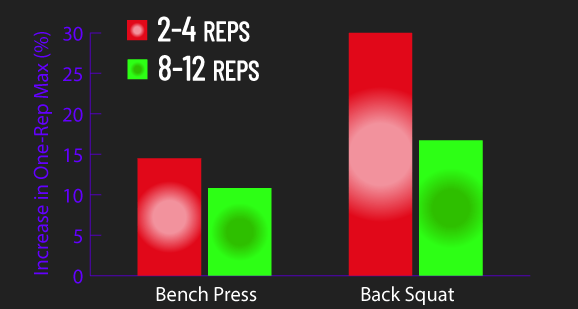
So in total, heavier load and lower rep training (5 or fewer reps) should probably make up a large part of a strength-oriented program.
Another point I’d like to touch on is the fact the initial Japanese study, very interestingly, looked at correlations between bench press strength gains and pectoralis major growth.
For both the 4 and 8 groups, there was no correlation between them. Yet, for the 12 group, there was indeed a correlation between strength gains and size gains.
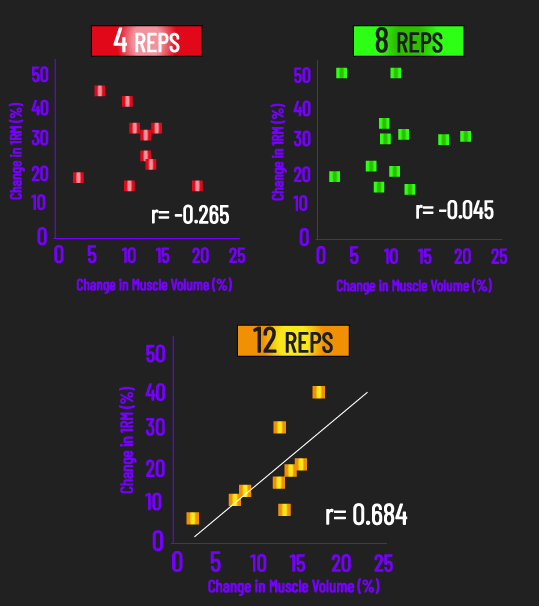
These findings are probably quite logical.
Muscle size likely contributes to strength (as muscle growth achieved via an increase in contractile components increases your strength capacity).
Yet, we also know adaptations in the nervous system that result in your brain and/or spinal cord sending stronger electrical signals to the muscle also play a role in strength. Heavier load training tends to stimulate these nervous system adaptations more.
Thus, the lack of correlation between strength and muscle in the 4 and 8 groups is probably because nervous system adaptations clouded the effects of hypertrophy on strength.
Whereas the 12 group probably experienced fewer nervous system adaptations, perhaps explaining why we were able to see a strength and size correlation with them.
I think this finding has a potentially interesting implication:
As an individual becomes more and more trained and essentially maxes out nervous system adaptations (and other non-hypertrophy-related factors like movement efficiency), muscle growth is one avenue by which you can further increase strength.
We know heavier load training (5 or fewer reps) can stimulate both nervous system and hypertrophy adaptations, but given you’ve maxed nervous system adaptations, you should be more concerned about the hypertrophy aspect.
However, we know that 5 or fewer reps may not be efficient for hypertrophy (you need extra sets), and because you’ve maxed out nervous system adaptations and now only care about hypertrophy, using higher reps can be viable in this context for increasing your strength.
Put another way, in well-strength-trained individuals, higher rep training can probably be an efficient route to try to get stronger by way of more muscle.
Having said all of this, a limitation is I have no idea when nervous system adaptations could max out. It’s commonly believed the bulk of nervous system adaptations occurs within the first few months of heavy enough training, and this may indeed be true. Yet, there’s still evidence of further nervous system adaptations in well-trained individuals (one and two).
Another problem is it’s theoretically possible someone maximizes (or at least practically maximizes) their hypertrophy before they even maximize nervous system adaptations.
Overall, more research is needed in this area.
At the very least, the logic we’ve overviewed probably demonstrates that higher rep training in strength-oriented athletes can very well be justifiable.
Part IV: Concurrent Strength & Hypertrophy Efficiently
Based on the initial study overviewed (plus some other evidence we overviewed), I think it’s reasonable to say approximately the 8 rep range is highly efficient for concurrently developing strength and muscle.
It’s not too heavy such that you have to perform extra sets for hypertrophy, but it’s still heavy enough to be great at stimulating nervous system adaptations.
For untrained individuals, it might be similarly effective to heavier loads for stimulating these nervous system adaptations, while in more trained individuals, it may not be quite as good, but it still likely is respectably effective.
On top of this, there’s some evidence that heavier load training (below 5 reps) may not be the most favorable for joint health in select individuals. For example, one of the aforementioned studies out of New York reported that in 2 of 10 individuals training with 7 sets of 3 reps to failure per exercise, joint-related injuries occurred.
Training around the 8 rep range may limit this problem.
Part V: Summary
Crystallizing everything, 6 to 35 reps are likely similarly effective per set for stimulating hypertrophy.
Training with 3-5 reps may require you to perform extra sets to see similar hypertrophy.
For strength, heavier loads and lower reps (5 or fewer reps) tend to be better, particularly in trained individuals.
Finally, the 8 rep range zone is likely highly efficient for concurrently developing strength and muscle.

